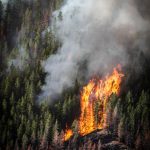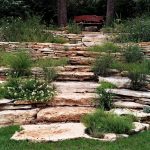by Ken Lain, the mountain gardener
Residents new to the mountains want to get back-to-nature, find solitude, and escape the rat race. Locally we call this the urban-wild land interface. However, with a woodland lifestyle come risks. For instance, this week the primary hazard is the danger of wildfire.
As a diehard gardener I take the middle ground on firewise landscaping. I believe that it is possible to have a landscape design that is beautiful as well as safe. Folks new to preparing for wildfire hazards can carry precautions to the extreme. Many fall in love with their chainsaws and cut down most landscape plants, then cover their yards with rock. In just a few paragraphs I’ll try to summarize years of wildfire training and teaching that is safe, sane, and can result in attractive landscaping.
The top priority is to create a landscape that has a defendable space. This is an area that will serve as a buffer zone should fire approach your home. The goal is to keep a fire moving “slow and low” until it can be extinguished. Some plants are more flammable than others, so by thinning any of these varieties that are nearest the house we will be able to keep a fire close to the ground and moving slowly, increasing time for fire fighting.
Evergreen conifers are high in combustible resins and waxes that make them evergreen  and durable, but also highly flammable. Close to the house you should reduce the number of juniper, pine, spruce and cedars; all are high in plant resins and burn easily. Replace them with deciduous plants; those are plants that lose their leaves in winter. Deciduous plants not only retain more water in their foliage, which make them much more difficult to burn, but they drop their foliage in autumn. To reduce combustible materials in the landscape even more, these leaves should not be left on the ground to dry.
and durable, but also highly flammable. Close to the house you should reduce the number of juniper, pine, spruce and cedars; all are high in plant resins and burn easily. Replace them with deciduous plants; those are plants that lose their leaves in winter. Deciduous plants not only retain more water in their foliage, which make them much more difficult to burn, but they drop their foliage in autumn. To reduce combustible materials in the landscape even more, these leaves should not be left on the ground to dry.
There is not enough space in this column for additional plant suggestions, but there are many choices. I have put together a list highlighting the landscape plants that are fire wise. It is entitled “Planting a Fire Wise Landscape”, and is free for the asking when you visit the garden center.
Characteristics of a firewise plant are five-fold:
- Supple leaves
- Water-like sap
- Thicker bark
- High moisture content
- Low resin content, like the Pow Wow Echinacea.
To increase your surroundings’ fire resistance, water and feed any style of land scape to keep it healthy. Water your existing natives once a month in summer until the monsoons arrive. Ornamental landscape plants appreciate a deep soak once a week. A layer of composted mulch helps suppress weeds and keeps moisture around plants, which is especially helpful in June.
scape to keep it healthy. Water your existing natives once a month in summer until the monsoons arrive. Ornamental landscape plants appreciate a deep soak once a week. A layer of composted mulch helps suppress weeds and keeps moisture around plants, which is especially helpful in June.
Avoid ladder fuels. These are dry grasses that ignite a taller shrub that catches the pine trees on fire, which then jumps to the roof. Remember, our goal with a fire wise landscape is to keep a fire on the ground, out of trees’ canopies, and off the roof. Ideally, create garden “islands” in the yard with an interesting plant mix separated from the next garden island by a driveway, patio, or rock lawn. This fire wise technique allows firefighters some space between gardens to fight the flames.
Clean debris from gutters and roof. Needles and leaves on the roof and gutters provide tinder for blowing sparks. Chip piles of brush and use as compost or remove it from your area.
The right landscape design is critical when planting in the urban-wild land interface. A fire  wise balance between existing trees, evergreens, and irrigation is tricky. It’s easy to get it wrong. To help Watters’ customers I called in a favor from a landscape design buddy of mine, Rich Olsen. Rich is a master designer who knows how to create designs that are fire wise and attractive.
wise balance between existing trees, evergreens, and irrigation is tricky. It’s easy to get it wrong. To help Watters’ customers I called in a favor from a landscape design buddy of mine, Rich Olsen. Rich is a master designer who knows how to create designs that are fire wise and attractive.
Rich has agreed to work for free every Wednesday morning (from 9:00 – 12:00) to help local gardeners figure out how to make their landscapes safe. He will modify a digital photo of your landscape and suggest improvements. You also may e-mail a garden photo to him at [email protected]. We have to love those people like Rich who care enough about their communities to offer their skills without charge. :-:)


Ken, my husband and I enjoyed your presentation at Hidden Valley yesterday. Your joyful energy is inspiring. Thanks so much.
PS. I love the graphics on your web.
It is so easy when a community is so receptive. You upbeat comments is proof of great students:)